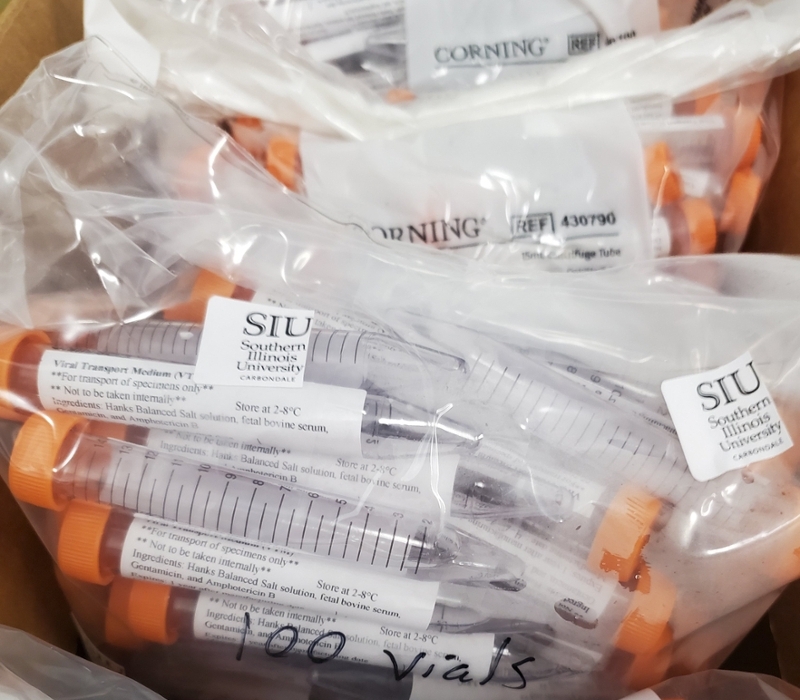
This batch was among the first 10,000 vials Viral Transport Medium formulated at SIU Carbondale delivered to the Illinois Department of Public Health earlier this week. (Photo provided)
April 17, 2020
SIU is first state university to deliver in key COVID-19 test substance shortage
CARBONDALE, Ill. — A team at Southern Illinois University Carbondale this week delivered its first round of a key substance needed for COVID-19 tests to health authorities in Springfield. SIU was the first university in the state to do so.
Andrew Wood, director of the School of Biological Sciences, on Tuesday hand-delivered the first 10,000 vials of Viral Transport Medium formulated at SIU to the Illinois Department of Public Health. SIU researchers, along with several other state universities, are working on making up the shortfall of the substance.
Gary Kinsel, vice chancellor for research at SIU, said he is proud of how well faculty are performing in meeting the ongoing challenges presented by the health emergency.
“It’s a source of great pride that our faculty have stepped up to provide such an important contribution to the state of Illinois during this pandemic,” Kinsel said. “I know that their efforts expand the state testing capacity and ultimately save lives.”
Substance is vital for COVID-19 testing
Viral Transport Medium (VTM) is a pH-buffered fluid with a specific formulation of salts, protein and other chemicals that maintains the genetic information of a virus until it can be tested. Faculty have been working around the clock organizing the effort to make the substance, which is in short supply because of the ongoing health emergency and large need for testing.
The batch was manufactured by a team of microbiologists and several students last week at SIU.
Scott Hamilton-Brehm, professor of microbiology and a leader of the effort, said the SIU team intends to keep the pace of 10,000 vials per week
“As long as we have supplies and people willing to help us, we can keep this pace,” Hamilton-Brehm said. “Our future challenge is keeping our supply line to the university.”
Many of the materials needed for the formulation come from other states while some come from storehouses in Chicago, Hamilton-Brehm said, and must be decontaminated for safety upon arrival. Normal delivery has been greatly affected by the virus outbreak, which in turn puts stress on SIU’s acquisition of materials.
“We have really great people here at SIU and we did a phenomenal job getting that first 10,000 vials out the door,” Hamilton-Brehm said. “Our challenge is that for all of our fantastic people, if we do not have the supplies we have to stop working.”
The pressure is on
Other challenges continue to arise. Along with keeping the supply chain functioning, simple day-to-day laboratory functions are stressed by the large amount of substance needed in such a short period of time. Hamilton-Brehm said challenges are to be expected in such a large undertaking.
“We learn, adapt, and evolve quickly in this type of situation,” he said. “One day it might be labels, another day it is filters, the next not enough people, and so on. As a manager, professor, and scientist you need to be dynamic and never rigid. Speed and dexterity is our strength here.”
And the pressure isn’t letting up: SIU has a contract with state government to provide 40,000 vials of VTM during the next four weeks. The breakneck pace of manufacture is being shouldered by a team of faculty and staff including Matt Geisler, Vjollca Konjufca, Buffy Ellsworth,Laxmi Sagwan-Barkdoll, Buck Hales and Karen Hales, as well as graduate students Trevor Murphy and Erik Velkme. Other volunteers from the departments of microbiology, public health, plant biology, chemistry and biochemistry and geology are supplementing the team, as well.
“It all takes a lot of effort and time from all of us, but we know this is for a good cause, we know this is a moment in time where sacrifice is needed to be victorious,” Hamilton-Brehm said. “Hopefully after we gain control over the virus we can return to our work and begin teaching and doing research again.”
Salukis rise to the challenges
Hamilton-Brehm said he’s read about other, larger universities with goals of manufacturing 20,000 vials per week with up to 40 volunteers.
“The first week we produced 10,000 vials with just six people,” he said. “This is proof we can accomplish huge efforts with just a few people.”
